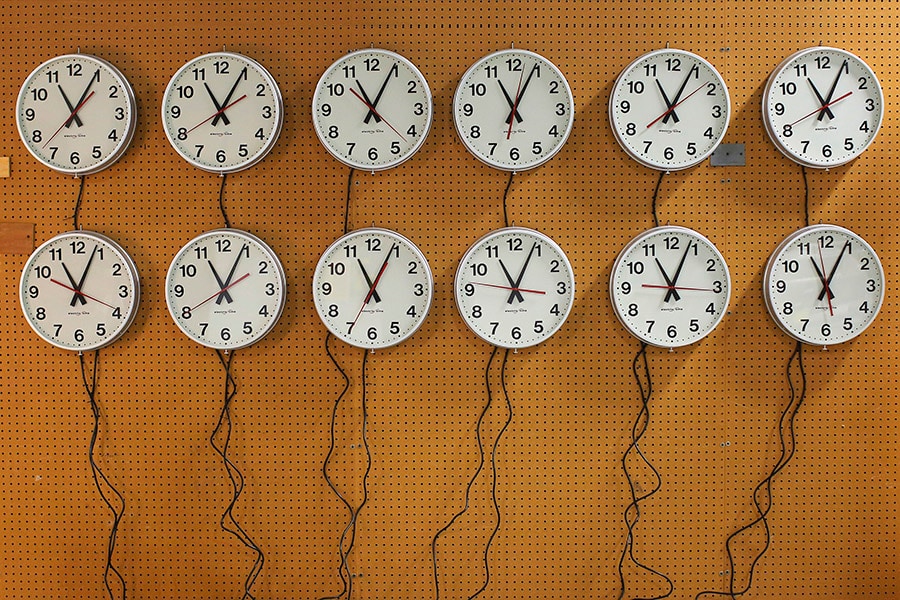
How the ticking clock kills
A new study reveals spikes in stress when employees are told to think of time as money

Image: Brian Snyder / Reuters
Many years ago, when Stanford University switched to a new payroll software platform, professor Jeffrey Pfeffer of Stanford Graduate School of Business noticed something interesting when he examined his pay statement. Even though he is not paid by the hour, the statement displayed an hourly pay rate. Curious, the organizational behavior professor sought to understand how the university came up with that number. The answer: The hourly pay was his annual salary divided by 2,080 — 52 weeks times 40 hours per week.
What was even more interesting was his psychological response to that information. Confronted with reminders about the economic worth of his time, Pfeffer noticed that he came to think of time as money.
More than a decade later, Pfeffer remains passionate about the topic of the economic evaluation of time, and he has good reason. With former Stanford GSB doctoral student Sanford DeVoe, who now teaches at the Anderson School of Management at UCLA, Pfeffer has done research showing that thinking of time as money changes people’s decisions about volunteering time and trading off working more hours for more money.
Pfeffer’s most recent research, coauthored with Dana R. Carney from the Haas School of Business at the University of California, Berkeley, demonstrates the physiological consequences of the economic evaluation of time. Their study concludes that people who are keenly aware of the economic value of their time — people who think of time as money — generally are more psychologically stressed and exhibit higher levels of the stress hormone cortisol that do people for whom the economic value of time is less salient.
Pfeffer and Carney were inspired by previous research on this topic, including a 2001 study by M. Cathleen Kaveny, now at Boston College. Kaveny studied why lawyers often are unsatisfied with their careers and sometimes leave the profession altogether, even though most of them enjoy high incomes and occupational prestige. She concluded that attorneys, whose time is accounted in billable minutes, are hyperaware of the ticking clock that rules their work lives. Even when they’re not working, they’re thinking about how much income they’re forgoing during off hours, such as while dining with friends or coaching a child’s soccer game.
To demonstrate the effects of the time-money awareness, Pfeffer and Carney recruited 104 test subjects and paid them to work for two hours for a fictitious company. They divided the recruits into two groups. Before they started the job, 50 of the workers were asked to calculate their per-minute pay rate based on earning $57.50 for two hours of work. The remaining workers were assigned the exact same tasks, but were not instructed to calculate their per-minute pay rate. In other words, both groups were guaranteed the same pay for the same two hours of work, but the first group proceeded with an upfront awareness of how much money they would earn per minute.
To test the physiological and psychological impact of that awareness, Pfeffer and Carney measured each subject’s salivary cortisol level — a physiological indicator of stress — at both the start and the end of their two-hour session. The results, Pfeffer says, were troubling. Cortisol levels were almost 25 percent higher in the time-is-money calculation group, whose members also seemed to find less pleasure during two breaks in the experiment in which they were allowed to look at art or listen to music.
“Cortisol is linked to all kinds of bad physical outcomes,” Pfeffer says. “A rise of almost 25 percent is a serious health consequence.”
Pfeffer says he finds that result particularly distressing given the way the American work culture has evolved. With more workers piecing together incomes in the so-called “gig” economy, rather than being on a full-time payroll, they’re more aware than ever of Benjamin Franklin’s adage that time is money. “The stress-inducing aspects of these new work arrangements may have implications for overall population health,” the study concludes.
“We’re moving in the wrong direction in many ways, and this is only one,” Pfeffer says. “People are continually calculating the economic value of their time. And all the research shows that when people are thinking about time and money, they’re not enjoying their lives. They become impatient. They don’t enjoy music, or sunsets. This calculation of what it costs to coach your kid’s soccer game is not a path to happiness.”
So why should employers care about the stress levels of their workers? Pfeffer’s study suggests three reasons: Health care costs are a significant burden on both society and employers, employee health affects productivity, and people’s health status is a reliable indicator of how well a social system is functioning.
But beyond that, he says, “We ought to care as much about people as polar bears. A lot of companies, particularly the big ones, talk about how much carbon they’re saving and how much packaging they’re saving. I certainly believe the physical environment is important. But the human environment is important as well.”
Pfeffer suggests employers look for ways to mitigate the time-is-money mentality, including moving toward annual salaries rather than hourly pay scales. “Every minute thinking about the value of your time is not very good,” he says. “We live in a completely overscheduled world, and that’s just not very healthy. And it’s not consistent with what happens in some other societies.”
The study notes that on the Greek island of Ikaria, people pay little attention to clocks — and live a very long time. “In Spain, they take a long lunch, have some wine, and relax,” Pfeffer adds. “It’s not like that here.”
This piece originally appeared in Stanford Business Insights from Stanford Graduate School of Business. To receive business ideas and insights from Stanford GSB click here: (To sign up: https://www.gsb.stanford.edu/insights/about/emails)




